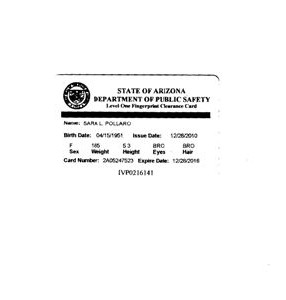

Two letters of reference (completed on the forms provided by the Board).(For more information on personal statements, please see the "Resources" section of our Forms & Resources page.)

Applicants also may want to describe the positive lifestyle changes they have made. Applicants should make sure to address every arrest, even if it did not appear on the letter from DPS, and even if the arrest did not lead to a conviction.

The application form also requires a personal statement that explains, from the applicant's perspective, every arrest that may be on your criminal history record. Applicants should not fail to answer any of the questions.
Application form (completed, signed, and notarized). A complete application must include at least the following. Failure to submit a complete application package will delay the process and may cause the application to be denied. īefore the Board looks at the application, it must receive a complete application package. Arizona fingerprint card download#
If you can't download the application, please contact us at (602) 265-0135 or. Please be sure to read the instructions carefully and to see the section on frequently asked questions.
In certain circumstances, individuals who hold fingerprint clearance cards that were issued prior to July 1, 2009, can use those fingerprint clearance cards in place of a Level I card.Īpplication's are available on the Forms and Resources page. Division of Developmental Disabilities employees, DES. Child Protective Services (CPS) employee, DES. Child care group home employees, Department of Health Services (DHS). Board of Fingerprinting members and employees. Adoption, Department of Economic Security (DES). (Also listed are the state agencies that regulate that profession or activity.) If your profession or activity is not listed below, then either a Level I card or a standard card will suffice. Level I cards are required for the following professions or activities. Standard cards correspond, for the most part, with the fingerprint clearance card that existed prior to the legislative changes. There are more types of criminal charges that can cause a Level I card to be denied or suspended, so the Level I card is more restrictive and harder to get. Beginning on July 1, 2009, DPS began issuing Level I fingerprint clearance cards, in addition to the standard fingerprint clearance cards. In 2009, a new law went into effect that created two types of fingerprint clearance cards rather than just one type. In most cases, individuals whose card is denied are able to apply for a good cause exception to the Board of Fingerprinting. If, after 30 business days, DPS still does not know the disposition of an offense, it will deny the card. DPS conducts research with a variety of law enforcement agencies to try to find out the disposition. Sometimes, though, the criminal record does not include disposition information. If a conviction exists, DPS denies the card. If a person's criminal record includes precluded offenses, DPS will see what the disposition - that is, the final result of an offense, such as conviction, no contest plea, dismissal, etc. Offenses that appear in this list are referred to as "precluded offenses." If there are any arrests on your record, DPS compares the criminal offenses with a list of offenses that would cause the denial or suspension of a fingerprint clearance card, such as assault, theft, drug offenses, as well as many others. DPS conducts a background check on your criminal history at both the state and national (i.e., FBI) levels. Individuals who apply for a fingerprint clearance card - whether a Level I fingerprint clearance card or a standard fingerprint clearance card (see below for an explanation of the difference) - submit this application to the Arizona Department of Public Safety (DPS), along with fingerprint imprints.







 0 kommentar(er)
0 kommentar(er)
